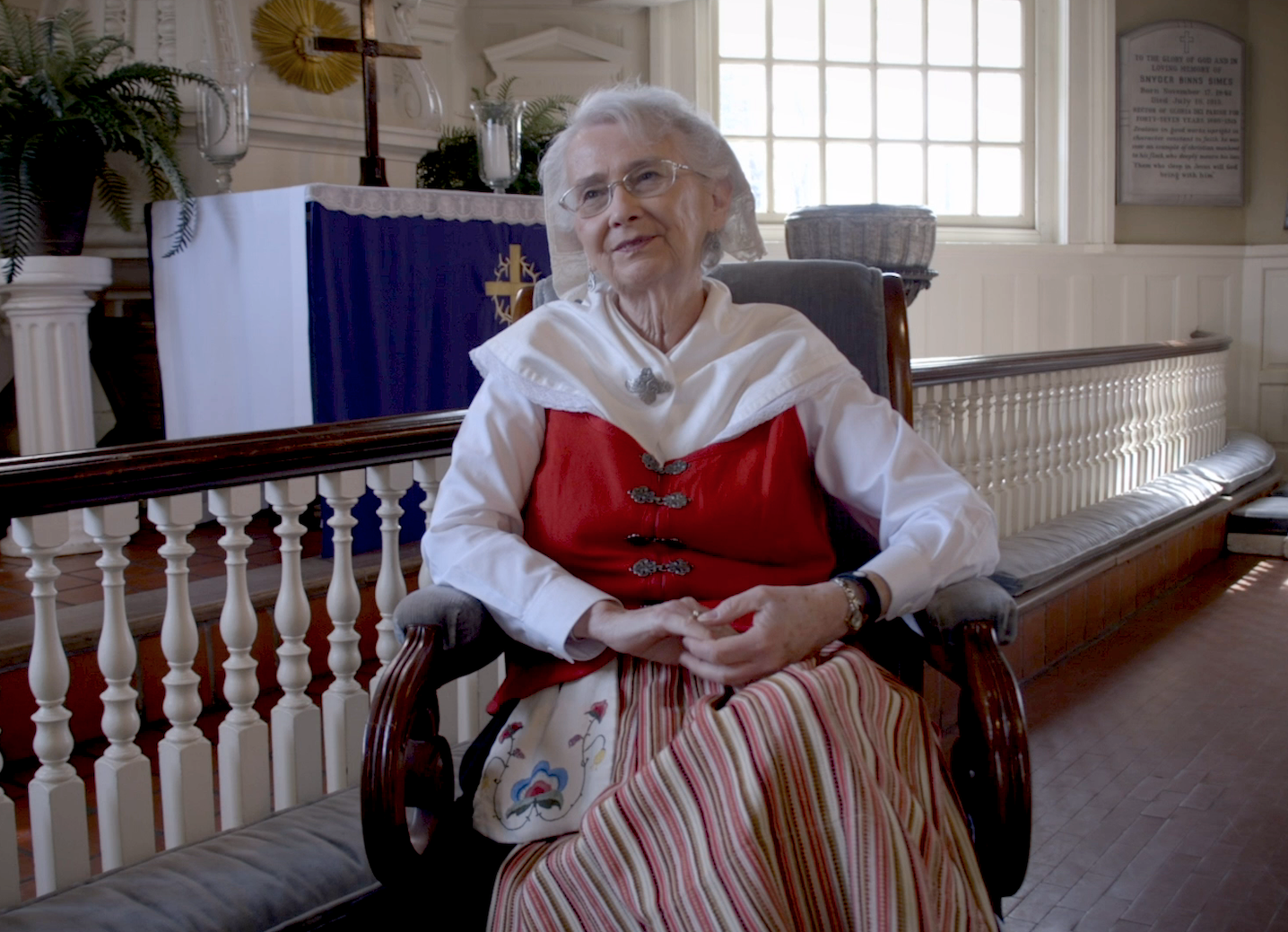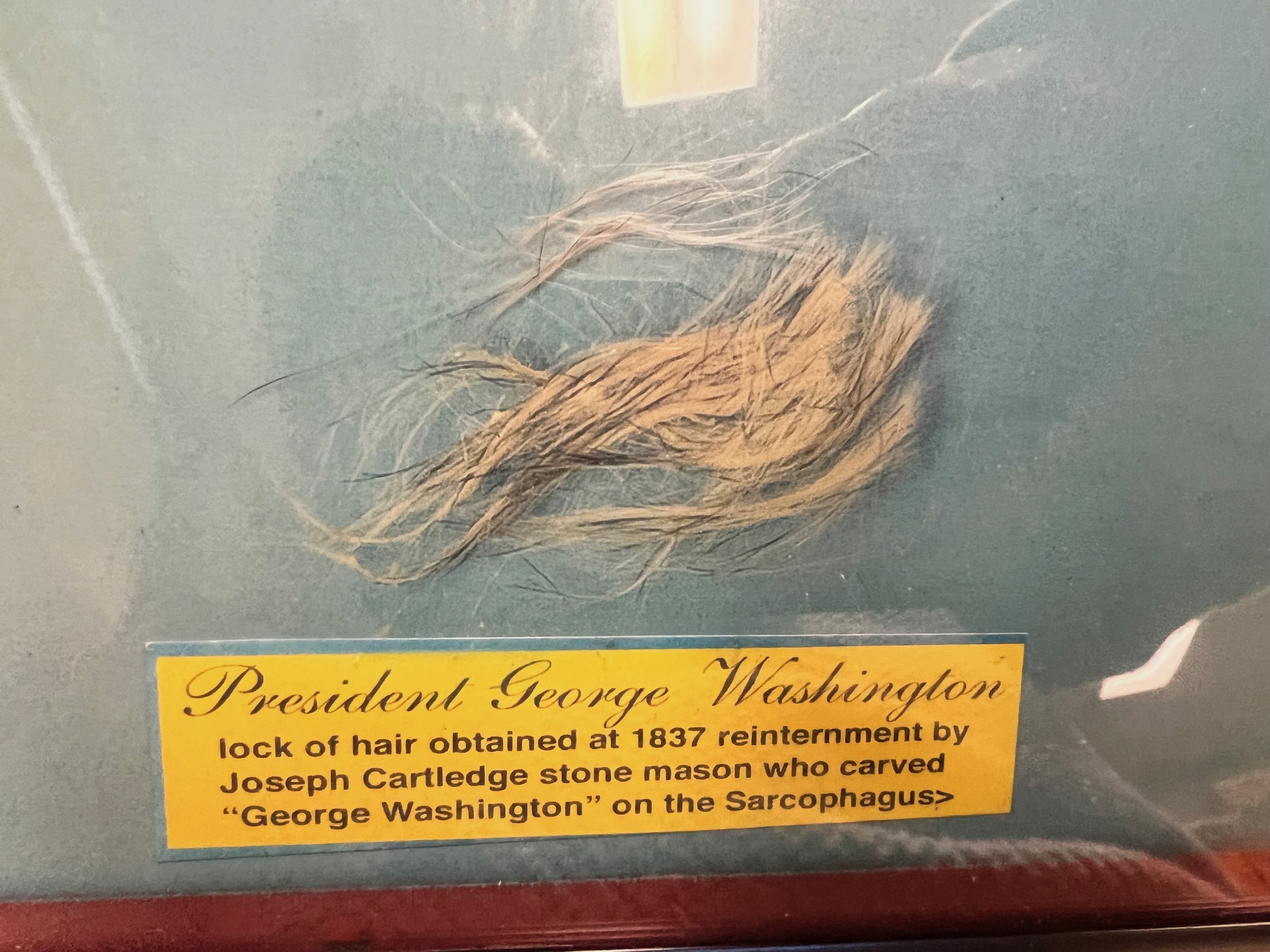Jeanette Woehr: History is in Her Blood
This intricate carving, designed by an ancestor of Jeanette Woehr's, is at the 40-foot mark inside the Washington Monument.
Photo courtesy of National Park Service.
While waiting for a tour of Gloria Dei (Old Swedes') Church to begin one day last September, I spoke briefly with Jeanette Woehr (sounds like “where”) – the church historian giving the tour.
That’s when I learned the immense role history and Gloria Dei have played in her life.
Jeanette’s family goes back to the 1500s and includes German ancestors on her father’s side … and English, Irish, Welsh, and Native American Lenape on her mom’s side. It’s really an All-American family, and her records take up three large binders of material.
What’s more, her relatives have been members of Gloria Dei since the 1820s. They lived for a time at Front and Prime Street, now Washington Avenue.
“Your family history is very important,” she says. “It’s been embedded in me. I’ve always been involved in history.”
That she has. Her aunt Ida May Cartledge was a historian at Gloria Dei for many years. Jeanette took over the duties in 1997, but helped her for many years before that.
Gloria Dei Church historian and archivist, Jeanette Woehr, has ancestors with direct links to several important monuments.
Surprised at the vault’s contents
Unlike her aunt, Jeanette – as a member of the Vestry – was able to enter the vault at the church. And what she found amazed her.
“Things were literally thrown in,” she says. “Cardboard fruit boxes, Bibles, books from 1500.” Jeanette and her husband Richard got a little red wagon, took everything out of the vault and began categorizing material by each century.
“I had no education on any of this,” she says. The Historical Society in Haddonfield was a huge help, suggesting items she needed, like acid-free boxes.
Aided by a matching grant, Jeanette computerized all Gloria Dei’s records from 1750 to 1995, including births, deaths, marriages and confirmations. It took her a well-documented 660 hours to do it.
Along the way, Jeanette has also researched her own family … and found some important names in her background.
Her prominent ancestors include these three people on her mother’s side:
Joseph Cartledge – He carved Washington’s name at Mount Vernon and took a lock of his hair
A stonecutter from Derbyshire, England, Joseph opened a monuments business at 945 Federal Street, Philadelphia. His nephew William later started another one on Lansdowne Avenue in Upper Darby, Delaware County.
After doing stonework at the British Museum in London, Joseph came to Philadelphia in response to an ad for work at Girard College.
It was a model building to work on, and one that took many years to complete.
When Girard College’s Founders Hall opened in 1848, it was then the second-most-expensive building in the country after the U.S. Capitol, says Inquirer architectural critic Inga Saffron.
Both were also designed by the same architect, Thomas U. Walter.
Before that, in 1837, Joseph Cartledge, then working for John Struthers of Philadelphia, had the privilege of carving the name “Washington” on a white sarcophagus used to house the remains of President George Washington at Mount Vernon, Va.
While Washington’s body was being moved from a wooden coffin into the sarcophagus during a re-interment, Joseph secretly cut off a lock of his hair, which he kept.
The Museum of Mourning at Arlington Cemetery in Drexel Hill, Pa. bought that valuable lock of hair from the family in 2011 for $2,500.
As a thank you for his handiwork on the sarcophagus, his boss John Struthers gave Joseph a priceless Chippendale chair now at Winterthur Estate in Delaware. At one point, the chair was on display at the Masonic Temple in Philadelphia.
Stephen Cartledge designed this Civil War Memorial in Muncy, Pa. Photo by William Fischer, Jr., June 22, 2018. Courtesy of HMdb.org
Stephen Cartledge – who worked on the Washington Monument and more
He was Joseph’s firstborn son and also a stonecutter, Stephen moved to Muncy, Pa. where he designed a Civil War Monument erected in 1869 that has a hand-carved American Eagle at the top. At the base, it simply says: S.G. Cartledge, Designer & Maker, Muncy, PA.
Artwork at 40 feet
Stephen also designed an elaborate carving at the 40-foot level inside the Washington Monument. Titled “Association of Journeymen” – it says “Stonecutters of Philadelphia,” with the words “United We Stand” at the bottom.
The work also includes a profile of George Washington, tools masons use, a variety of decorative columns, the date July 9, 1850, and the words “designed by Stephen Cartledge” at the bottom left. The work was executed by John Stewart.
Photo of Cyrus Carver Cartledge and his wife Emma Wallens Cartledge.
Cyrus Carver Cartledge – wounded at Little Round Top
The sixth of eight children born to Joseph Cartledge and Mary Ann Carver, he was also a Civil War hero. Cyrus was wounded on his left side at Little Round Top, Gettysburg, Pa. on July 2, 1863.
Even though the bullet remained in his side until his death, he was healthy enough to father five boys after the war. He recovered from his injuries at Broad Street Hospital at Broad and Cherry Streets in Philadelphia.
Jeanette was thrilled when she spotted Cyrus’ name on the Pennsylvania monument at Gettysburg.
Nowadays, she continues to conduct frequent tours of Gloria Dei and has also been scanning old records to make them available online. She’s part of an archival project spearheaded by Christ Church Preservation Trust to digitize some 41,000 records from Philadelphia’s oldest congregations. The project is funded by The Andrew W. Mellon Foundation.
Jeanette also transcribes the scanned info. It’s hard work, because the handwriting is difficult to read. Moreover, the Gloria Dei records are in Swedish, a language she doesn’t know. So, on the one or two documents she couldn’t figure out, she asked emeritus board member Dr. Kim-Eric Williams, who speaks Swedish, for help.
Jeanette also serves as a fulltime ambassador for Gloria Dei Church.
She’s proud to say she was only two weeks old when she first entered Gloria Dei. “I sat in the same pew for 70 years. It’s just part of me. The church has always been in my life.”
Historic Gloria Dei Facts from Jeanette Woehr
“We were here before William Penn was born."
“This is the oldest church in Pennsylvania.”
“Betsy Ross was married in this church.” (Jeanette was, too.)
Interesting Oddities
Jeanette’s family used to joke that the Cartledge family couldn’t spell its own name. They were right.
Three Cartledge children of Cyrus C. and Emma Cartledge – who died young – were buried in one grave. However, the stonecutter, misspelled the name as Carteledge with an extra “E.” He probably caught hell. But it’s hard to erase a mistake on a stone monument.
Cartledge, a stonecutter, married a woman named Mary Ann Carver. So the family had both a cutter and a carver.
Fast Facts
Name: Jeanette Woehr
Roles at Gloria Dei Church: Chair, history committee; liturgy committee, vestry
Roles at Historic Gloria Dei Preservation Corporation: Vice Chair, research committee, tour guide
Mother of: 3 children
Job Status: Retired
Past Job: Executive assistant, Ronald McDonald House Charities for over 11 years
Some Sources:
https://bvneighbors.medium.com/washington-avenue-factory-district-c06e526ef5a8
https://commons.wikimedia.org/wiki/File:Broad_and_Prime_Street_Station_Philadelphia.jpg
https://jeffersonsquarepark.org/park-history/
https://philadelphiaencyclopedia.org/essays/girard-college/
https://religionunplugged.com/news/2022/3/18/the-oldest-church-in-philadelphia-holds-together-brick-by-historical-brick
https://www.hmdb.org/m.asp?m=120756
https://www.librarycompany.org/laurelhill/gravelot.htm
https://www.nps.gov/articles/association-of-journeymen-stoncutters-40-level.htm
https://www.old-swedes.org/pages/history
https://www.philadelphiabuildings.org/pab/app/ar_display.cfm/127005
https://www.philadelphiabuildings.org/pab/app/ar_display.cfm/22755
https://www.philadelphiabuildings.org/pab/app/ar_display.cfm/28529
https://www.phillyarchaeology.net/research/project-report-index/washingtonavenueproject/
https://www.ushistory.org/philadelphia/formerstreets.htm
https://www.zenger.news/2022/06/08/historic-philadelphia-church-recalls-new-swedens-early-presence-in-the-u-s/




